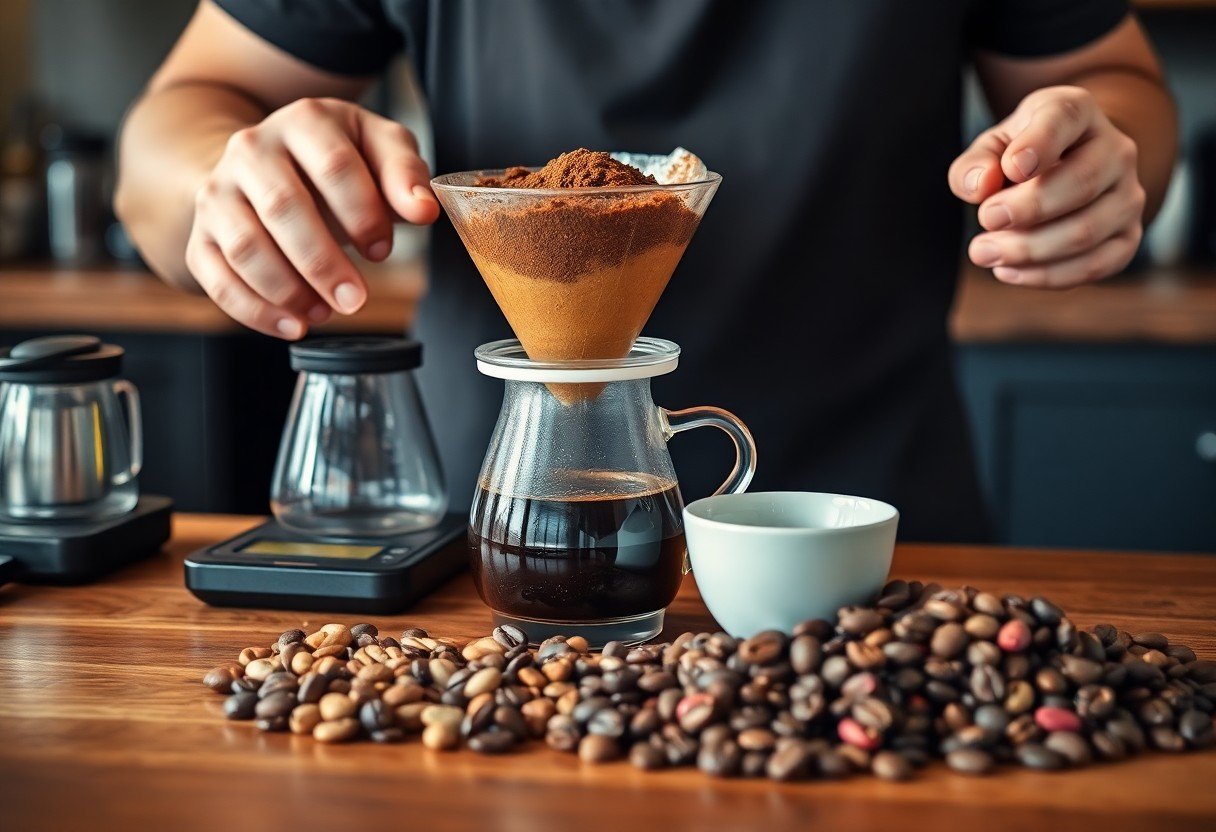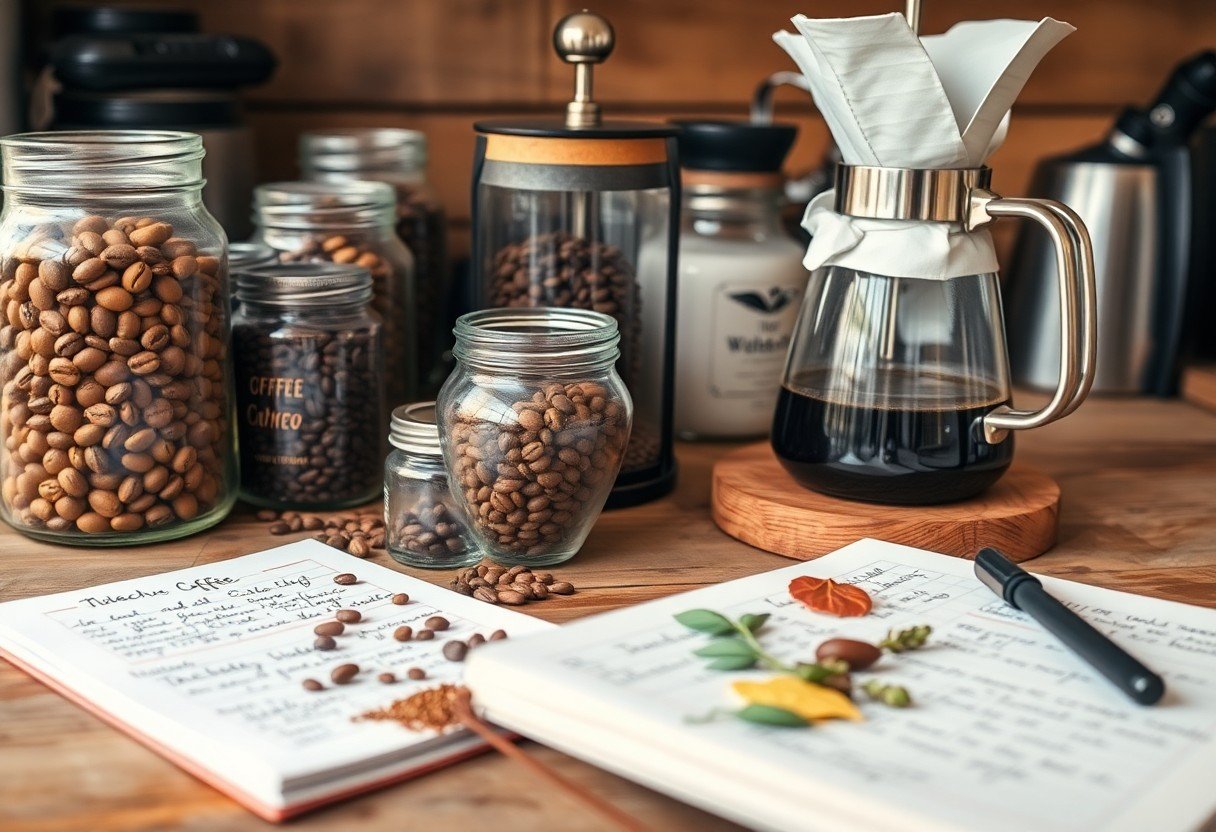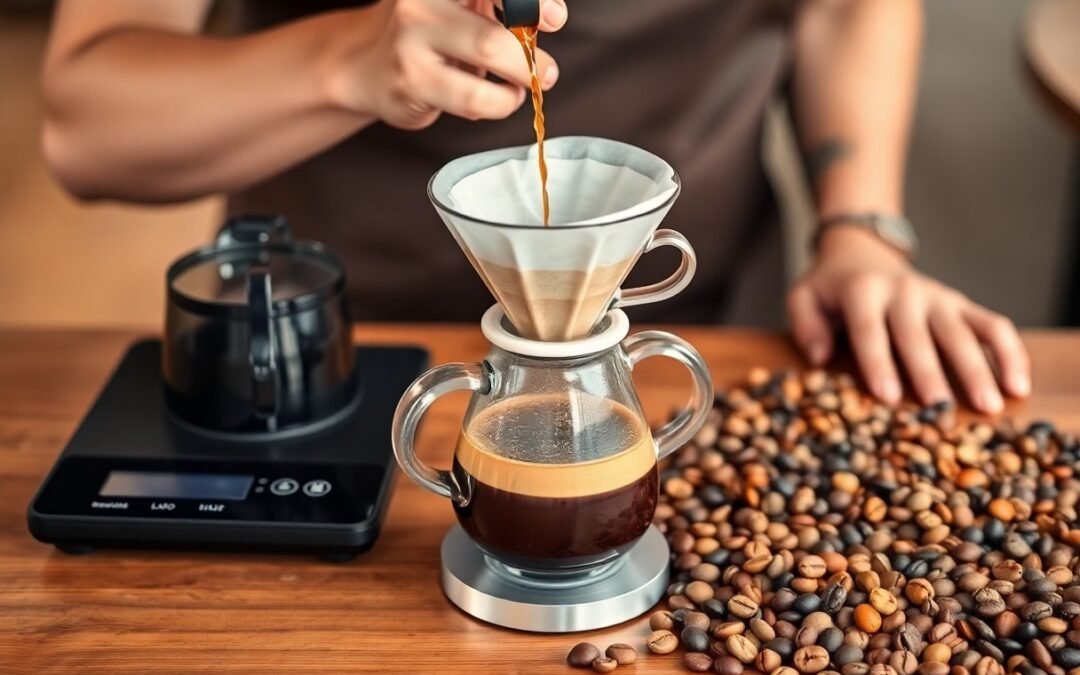Flavor exploration in artisan coffee is a journey that can transform your brewing experience. You can elevate your appreciation by understanding the nuances of various beans, roasting methods, and brewing techniques. This guide will take you through practical steps to unlock and savor the complex flavor profiles found in artisan coffees, allowing you to enhance your tasting skills and enjoy coffee like never before.
Decoding Coffee Beans: The Flavor Spectrum
Your journey into the flavor spectrum of coffee beans begins with understanding the myriad of taste profiles that different beans can offer. From fruity and floral to nutty and chocolatey, each bean carries its own signature characteristics influenced by its origin, processing methods, and roast levels. This spectrum provides the palette for crafting complex culinary experiences and allows you to tailor your coffee choice to suit your palate.
Identifying Bean Origins and Their Distinct Characteristics
You can discover fascinating flavors by exploring various coffee bean origins. For instance, Ethiopian beans often exhibit bright, fruity notes, while Colombian varieties might feature a balanced body and rich chocolate undertones. Factors such as soil composition, altitude, and climate conditions shape these distinct characteristics, making it vital to appreciate each origin’s contribution to the coffee flavor spectrum.
Understanding Processing Methods and Their Flavor Impact
The processing method used on coffee beans significantly influences their flavor profile. Whether through washing, natural drying, or honey processing, each technique imparts different notes and mouthfeel. Wash-processed coffees typically present cleaner, brighter flavors, while naturally processed beans often showcase deeper fruitiness and complexity.
Mastering the art of roasting is vital for unlocking the full spectrum of flavors in coffee. This process transforms raw green beans into aromatic profiles, revealing complex notes ranging from fruity and floral to nutty and chocolaty. Each roast level impacts acidity, sweetness, and body, allowing you to tailor the coffee experience to your preference. Recognizing the intricate relationship between time, temperature, and development stages helps you create unique flavor layers that will elevate your brews beyond the ordinary.
Examining Roast Levels and Their Influence on Taste
Roast levels—light, medium, and dark—each impart distinct characteristics to your coffee. Light roasts enhance the bean’s original flavors, highlighting acidity and brightness, while medium roasts balance sweetness and acidity, introducing more depth. Dark roasts, on the other hand, emphasize boldness and bitterness, often masking the bean’s intrinsic qualities. By experimenting with different roast levels, you can unlock a range of flavor profiles that cater to your palate.
Mastering Home Roasting Techniques for Enhanced Profiles
Home roasting techniques, such as using an air roaster or stovetop popper, provide control over each batch, allowing you to experiment with various profiles. Keep an eye on color changes and listen for the first and second crack, as these cues reveal the beans’ development stages. To enhance flavor complexity, adjust your roasting time and temperature to achieve your desired roast level, making notes for consistency. With practice, you’ll unlock distinctive tastes that perfectly suit your preferences.

Brewing Techniques: Unleashing the Full Potential
Mastering brewing techniques is vital for unlocking the intricate flavor profiles hidden within your coffee beans. By experimenting with various methods, you can highlight distinct characteristics that enhance your overall tasting experience. Each technique brings forth unique flavors and aromas, allowing you to tailor your brew to your specific palate.
Exploring Brewing Methods and Their Unique Flavor Extraction
Diving into different brewing methods can dramatically influence the taste of your coffee. Techniques such as pour-over, French press, and espresso utilize varied water flow, pressure, and contact time to extract flavors differently. For instance, pour-over emphasizes clarity and brightness, while French press delivers a fuller body, showcasing the richness of bold beans.
Optimal Brew Parameters: Time, Temperature, and Grind Size
Fine-tuning your brew parameters, including time, temperature, and grind size, is key to extracting the best flavors from your coffee. Each element plays a significant role in the overall outcome. For example, a coarser grind with longer brew time may result in an under-extraction, while a finer grind at higher temperatures can lead to bitter flavors.
Optimal Brew Parameters
| Parameter | Recommendation |
| Brew Time | 2-4 minutes for pour-over; 4-5 minutes for French press |
| Temperature | 195-205°F (90-96°C) |
| Grind Size | Coarse for immersion, medium for drip, fine for espresso |
Adjusting these parameters can elevate your coffee experience. Brew time should align with your method; for a French press, allowing 4-5 minutes permits optimal flavor extraction. The ideal temperature falls between 195°F and 205°F, ensuring balanced extraction without bitterness. Lastly, selecting the correct grind size is vital; a finer grind suits espresso, while a coarser grind works best for methods like French press, allowing for full flavor release without over-extraction.
Tasting Like a Pro: Developing Your Palate
Developing your palate is crucial for distinguishing the subtleties in artisan coffee. Engaging your senses to recognize different characteristics takes practice, but it’s a rewarding journey. Start by sampling a variety of beans from different regions, paying attention to how each unique origin influences taste. As you try different brews, take notes on flavors and aromas that stand out to you, gradually refining your ability to distinguish between complex profiles.
The Language of Coffee: Describing Flavors and Aromas
To effectively communicate your coffee experiences, familiarize yourself with the flavor vocabulary that describes various tastes and aromas. Terms like “bright,” “earthy,” or “fruity” enable you to articulate your impressions. An extensive flavor wheel can help you identify and categorize the diverse notes present in your coffee, enhancing your ability to discuss and compare different brews with others.
Training Exercises to Sharpen Your Sensory Perception
Sharpening your sensory perception through targeted exercises can significantly enhance your coffee tasting skills. Engage in aroma and taste comparison activities using similar flavor profiles, such as different chocolate types or fruits. By concentrating on specific notes, you train your brain to identify subtleties in coffee more effectively. Regular blind tastings allow you to rely on your instinct instead of preconceived notions, fostering a more authentic tasting experience.
One effective exercise involves conducting a “flavor matching” session with various coffees and specific ingredients. Choose a selection of fruits, nuts, or spices closely related to coffee flavors, then taste each one alongside different brews. For example, pair a medium roast with dried apricots and a dark roast with dark chocolate. Not only will you enhance your ability to pinpoint flavors, but you’ll also create lasting connections between coffee and its corresponding tasting notes, building a more profound appreciation of the beverage.

Creating Your Signature Blends: Experimentation and Innovation
Crafting your unique coffee blend is a journey of exploration and creativity. By experimenting with various bean origins, roasting levels, and processing methods, you can discover distinctive flavors that resonate with your palate. Consider keeping a detailed log of your blends, noting their characteristics and the adjustments you make. Each attempt teaches you something new, paving the way for your signature blend that reflects your style and preferences.
Combining Flavors: Techniques for Crafting Unique Blends
Combining flavors in coffee requires an understanding of how different beans interact with one another. Start by selecting complementary origins that enhance each other’s strengths, such as pairing a bright Ethiopian Yirgacheffe with a chocolatey Colombian bean. Experiment with blending ratios, adjusting the percentages until you achieve a harmonious profile. Tasting each iteration will guide you toward a blend that is both complex and uniquely satisfying.
Balancing Sweetness, Acidity, and Bitterness for Harmony
Achieving balance among sweetness, acidity, and bitterness is key to a well-rounded coffee blend. Each element contributes to overall flavor complexity, making it crucial to find the right proportions. For instance, enhancing sweetness can be achieved through natural or honey-processed beans, while acidity can be introduced with light roasted varieties. Carefully adjusting these elements while tasting will lead you to a harmonious cup.
Striking the right balance among sweetness, acidity, and bitterness requires a delicate approach. You might begin with a foundation of naturally sweet beans, like those from Brazil or Guatemala, to ensure a pleasant taste experience. Then, layer in light-roasted Ethiopian coffee for its bright acidity, providing a refreshing contrast. Incorporating a small amount of a bitter coffee, like a Sumatran bean, can ground the blend, creating depth without overpowering the sweetness. The key lies in constant tasting and incremental adjustments, helping you refine your blend to achieve a harmonious cup that excites the palate.
Final Words
On the whole, unlocking complex artisan coffee flavor profiles requires your attention to detail and a willingness to experiment. By mastering your brewing method, selecting high-quality beans, and adjusting variables like grind size and water temperature, you will enhance your ability to appreciate and create nuanced flavors. Engage your senses, explore different origins, and fine-tune your technique with each cup you brew. Your journey into the world of artisan coffee will not only deepen your understanding but also elevate your overall coffee experience.
FAQ
Q: What is the first step in unlocking complex artisan coffee flavor profiles?
A: Start with high-quality, freshly roasted coffee beans. Select single-origin beans, as they often highlight unique flavor notes specific to their region.
Q: How does grind size affect coffee flavor?
A: Grind size impacts extraction. A coarser grind is better for methods like French press, while a finer grind suits espresso. Adjust grind size based on your brewing method to optimize flavor extraction.
Q: What brewing methods best highlight complex flavors?
A: Methods like pour-over, Aeropress, and siphon brewing are excellent for showcasing intricate flavors due to their ability to control water temperature and brew time.
Q: Why is water quality important in coffee brewing?
A: Water quality affects flavor extraction. Use filtered water free from impurities to ensure that the natural flavors of the coffee shine through without interference from contaminants.
Q: How can I experiment with coffee flavors?
A: Experiment by varying brewing times, water temperatures, and coffee-to-water ratios. Keeping detailed notes will help identify which adjustments enhance flavor profiles the most.

